|
MobileDemand xTablet Flex 10
Intel "Bay Trail" quad-core powered 10.1-inch Windows 8.1 capacitive multi-touch tablet in a custom-designed, preinstalled protective case costs less than an iPad Air 2
by Conrad H. Blickenstorfer
MobileDemand introduced the xTablet Flex 10 in August 2014 as the second in a series of thin and light rugged tablets the company introduced in 2014. The new "business-loaded" xTablet Flex 10 is designed to deliver productivity improvements to an increasingly wide-ranging set of customers who require more ruggedness than consumer-grade tablets can deliver, but at a price that is not prohibitive.
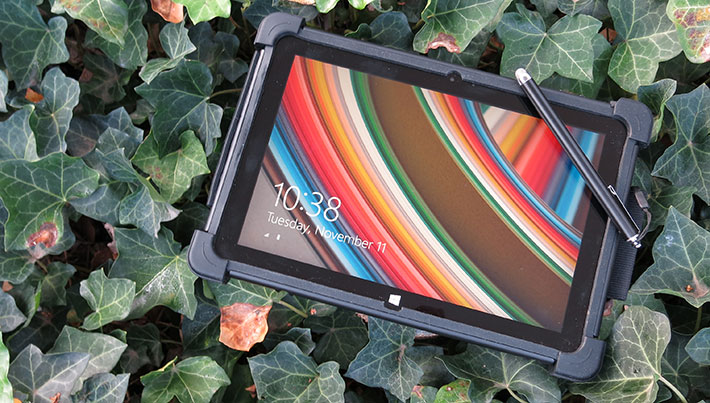
MobileDemand does that by pre-packaging and assembling what is essentially a standard, albeit fully loaded, consumer/business Windows tablet with a competent protective case with bumpers and a carry handle, a scratch-proof screen protector, and other touches and implements essential to a rugged device. So instead of searching for a case that may or may not do the job, buyers get a tablet with a heavy-duty case designed by experts in rugged Tablet PCs. And what does this cost, the whole package? US$695 with Windows 8.1, and US$845 with Windows 8.1 Professional. To put that in perspective, the Microsoft Surface Pro 3 with 64GB, a Core i3 chip and Windows 8.1 Pro is US$799. A 128GB iPad Air 2 is $699. Which means the price is right there.
That price and approach means that with the xTablet Flex 10, MobileDemand is entering entirely new territory. Ever since the iPad legitimized the tablet form factor, which is now selling by the hundreds of millions, rugged tablet vendors have struggled to successfully participate in the bonanza. First it was older rugged tablet technology that buyers spoiled by sleek, speedy procap media tablets were reluctant to accept, then it was the price. Even enterprise buyers bought inexpensive consumer tablets and stuck them in a case. If they broke, they simply replaced them. There is considerable debate in the rugged industry as to whether it's a good idea to put consumer tech in a case. Well, MobileDemand obviously intends to find out for itself.
But first, in accurate scale, let's see where the xTablet Flex 10 (left) fits in compared to the company's higher-end thin & light xTablet T1400 (middle), and the older fully rugged T7200 (right) that has a wide-format 7-inch screen.

MobileDemand's Flex platform
While both the Flex 10 and the T1400 have 10.1-inch screens and both were introduced during 2014 as part of MobileDemand's new line of thin and light rugged tablets, there's is a fundamental difference between the two. The T1400 was designed and built as a cohesive rugged tablet with significant performance and capabilities, whereas with the Flex 10, making a ruggedized package available at the lowest possible price was the primary objective.
To make that possible, MobileDemand sourced a more or less generic tablet that met the company's features and performance goals, custom-designed a protective rubber boot with thick bumpers to cradle that tablet, and that assembly then goes into a sturdy polycarbonate backplate. The picture below shows the three components, the tablet itself, the backplate, and the rubber boot:

But cladding the tablet with hefty protection wasn't all MobileDemand did; they also designed the backplate to accommodate a briefcase carrying handle, a heavy duty handstrap, and an easily accessible holster for the unit's capacitive stylus. All of this is included in the price. Customers ordering an xTablet Flex 10 will receive the unit exactly as shown in the pictures below.
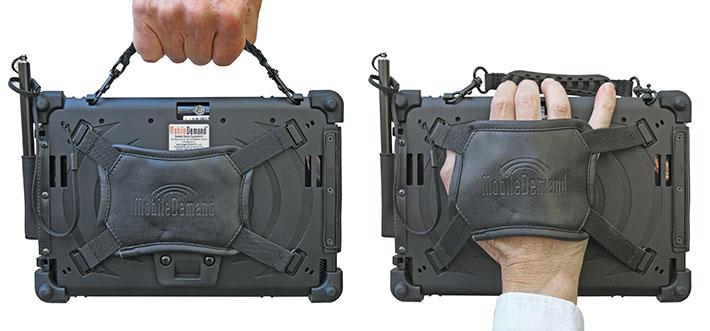
What differentiates the xTablet Flex 10 from buying a tablet and then a case for it is that it all comes preassembled and the case was designed by a company that has vast experience in rugged tablets. And there's an additional piece of protection that isn't visible in the pictures above: the xTablet Flex 10 also comes with a pre-applied screen protector that's not just a sheet of plastic but scratch-proof glass with a special oleophobic (fingerprint-resistant) coating. According to MobileDemand, it improves impact resistance by 20% — much welcome extra protection.
Below is a look at the xTablet Flex 10 from the front and from all four sides. We photoshopped out the handstrap on the backside of the tablet to better show just how thin and compact this tablet is even inside its case.
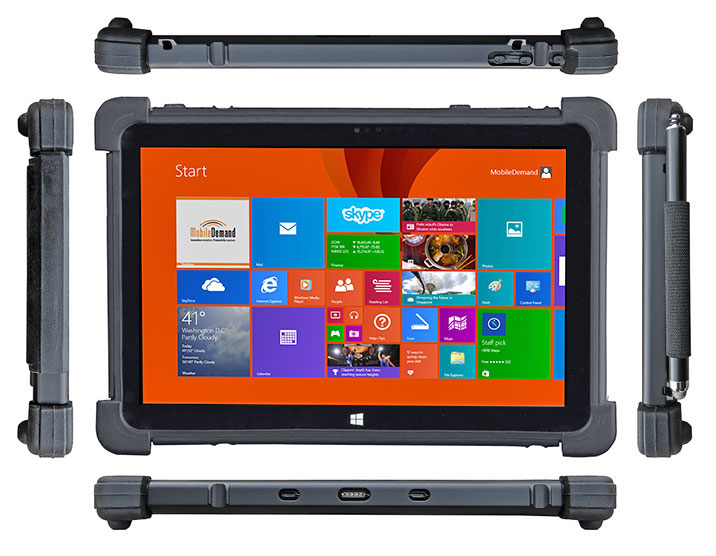
In these pictures the xTablet Flex 10 looks almost indistinguishable from a regular rugged tablet where the protection is an integral part of the design. In actual use the difference is more pronounced as the protective boot is made of very soft rubber so that it can be pulled over the tablet.
The below picture shows a close-up of the left side of the xTablet Flex 10, both with and without the protective case and boot. The picture shows how slender the base tablet is.

Note that in the upper picture we photoshopped off the soft protective rubber plug that covers all I/O on the left side of the tablet.
As far as I/O goes, from left to right, there is a small microphone hole, a micro USB port that's used for charging the tablet, a micro HDMI port, the micro SDHC/SDXC card slot, then the blue USB 3.0 port and a regular USB 2.0 port, both full size, and finally a standard 3.5mm audio in/out jack.
What we especially appreciate here are the two full-size USB ports, as they are significantly less prone to damage than the tiny and flimsier micro slots and connectors of any kind. The latter are sized to fit into phones and other small devices, but they really shouldn't be used in their present form in anything rugged.
Intel "Bay Trail" processor
Computing power comes from a 1.46GHz quad-core Intel Z3770 processor that can reach burst speeds up to 2.4GHz. It belongs to Intel's next-gen "Bay Trail" platform. The Bay Trail CPU architecture employs 22nm process technology and is a major advance in Atom microprocessor design, the first since the platform arrived a few years ago. 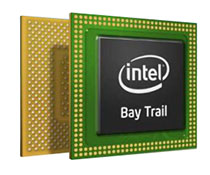 Note that turbo boost is called "burst frequency" in the Bay Trail lineup, and that an implementation of the clever power-saving "active idle" feature from Haswell core processors is apparently there as well. Note that turbo boost is called "burst frequency" in the Bay Trail lineup, and that an implementation of the clever power-saving "active idle" feature from Haswell core processors is apparently there as well.
That said, the Bay Trail processor platform is somewhat confusing as it includes not just Atom but also Celeron and even Pentium branded chips. The N2920 used in MobileDemand's xTablet T1400 is sold by Intel as a Celeron whereas Intel lists the Flex 10's Z3770 as an Atom. Both are quad-core chips with Intel HD Graphics and, according to their specs, are quite evenly matched. For full Z3770 specs, see Intel's Z3770 product sheet.
While even detailed examination of Intel's literature provides few clues as to what the relevant, real-world differences are between the various Bay Trail processor lines, it does appear that Intel views the Z-Series for lower cost tablets and perhaps even smartphones, whereas the significantly more costly N-Series is for higher end tablets.
|
PassMark 6.1
|
MobileDemand
|
MobileDemand
|
|
Model
|
xTablet Flex 10
|
xTablet T1400
|
|
OS
|
Win 8.1 (32-bit)
|
Win 8.1 (64-bit)
|
|
Processor Type
|
Intel Atom
|
Intel Celeron
|
|
Processor Model
|
Z3770
|
N2920
|
|
CPU Speed
|
1.46Hz
|
1.86Hz
|
|
Max Burst Speed
|
2.39Hz
|
2.00Hz
|
|
Scenario Design Power (TDP)
|
2.0 watts
|
4.5 watts
|
|
CPU Mark
|
1,590.9
|
2,014.7
|
|
2D Graphics Mark
|
179.8
|
153.1
|
|
Memory Mark
|
412.8
|
409.9
|
|
Disk Mark
|
294.4
|
2,048.3
|
|
3D Graphics Mark
|
127.3
|
115.3
|
|
Overall PassMark
|
603.2
|
1,062.7
|
|
CrystalMark
|
|
|
|
ALU
|
30,027
|
26,714
|
|
FPU
|
18,413
|
22,541
|
|
MEM
|
22,904
|
16,411
|
|
HDD
|
10,634
|
36,655
|
|
GDI
|
5,793
|
4,816
|
|
D2D
|
3,216
|
3,335
|
|
OGL
|
3,366
|
3,207
|
|
Overall CrystalMark
|
94,353
|
113,679
|
Another irritating development is that Intel has started to use SDP ("Scenario Design Power") instead of the more common TDP ("Thermal Design Power"). TDP indicates the maximum amount of heat in watts a system's cooling must be able to remove, giving a pretty good indication of the chip's overall performance, whereas SDP is the amount of heat to be removed under benign conditions, i.e. standard tablet apps and no temperature extremes. "Burst speed," likewise, is just the speed the processor may reach under ideal conditions. We take this as meaning that if things get hot, the chip slows down.
On the plus side, the graphics cores integrated into Bay Trail systems are of the same HD 4000 architecture and variety as those used in Intel's 3rd generation "Ivy Bridge" processors, albeit with fewer execution units (four instead of several times that number) and lower clock speeds. Still, that means the new graphics support most of the same APIs and features, including DirectX 11, OpenGL 4.0, and OpenCL 1.2.
As is, the table to the left shows our benchmark results for the Z3770-based xTablet Flex 10 and the N2920-based xTablet T1400. MobileDemand told us their own benchmarks showed the higher-end T1400's CPU performance about 20% better than the Flex 10's, with 2D graphics about 15% better and 3D graphics 7-10% better. Our own numbers agreed on the CPU, but the Flex 10 more than held its own in memory and graphics performance.
There's one area where the Flex 10's benchmark numbers came up short, and that's disk. That's because the higher-end T1400 uses high-performance SSD (solid state disk) with a high-speed mSATA interface whereas the economy Flex 10 uses eMMC (similar to memory cards and USB sticks). Both are flash storage, but the controllers and chips used in SSDs are faster and much more sophisticated. As a result, the Flex 10 scores much lower in disk performance, enough to put a significant gap in overall performance between the Flex 10 and the T1400.
That's not to say, however, that the Flex 10 is slow. In fact, MobileDemand's low-cost tablet feels quick and snappy in everyday use.
Power consumption: amazingly low
For battery life, we didn't expect all that much from a 10-inch tablet with a miserly but rather powerful Intel processor and a battery of less than 30 watt-hours.
We used the PassMark BatteryMon utility to examine power draw under different settings. We discovered that the Windows Power Settings control panel, which usually allows you to select from various power settings, in the Flex 10 was limited to "Balanced." The explanation in the Windows Help panel was that this was because of the system's InstantGo (see Wiki on InstantGo) that allows systems to wake up instantly from sleep with apps and data up to date.
When running the drawdown test, with the tablet's backlight set to its dimmest, we saw an amazingly low 3.2 watts. With the backlight in normal indoor setting, that rose to 3.7 watts and with the backlight at its maximum, it rose to 5.7 watts.
3.2 watts is pretty much the lowest power draw we've ever seen in our lab. If the unlabeled battery indeed provides 29 watt-hours as the specs claim, that would translate into a theoretical 9 hours of battery life. Even with the backlight on full bright, it would still mean 5 hours until a full battery is completely drained.
Real world battery life, of course, greatly varies depending on usage patterns. But one thing is for sure: between the Intel Z3770 chip and the tablet's design and setup, at least in benchmark testing, the Flex 10 is very power-efficient.
A look inside
Most xTablet Flex 10 customers may never even remove the tablet from its protective enclosure. At RuggedPCReview.com, we always want to know what's inside as that provides important clues to a device's quality of design and execution.
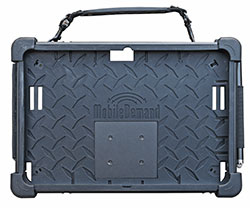 Taking apart the Flex 10 means you first have to separate the tablet from its elaborate protective plastic/rubber case. This requires careful twisting and prodding to torque the tablet out of its cocoon. Taking apart the Flex 10 means you first have to separate the tablet from its elaborate protective plastic/rubber case. This requires careful twisting and prodding to torque the tablet out of its cocoon.
Once that's done, you're holding in your hands the bare Flex 10, a sleek device measuring 10.1 x 6.8 inches, and perhaps 0.4 inches thick at its thickest part in the center where it must accommodate the two full-size USB ports. The tablet tapers off towards the top and bottom to a thickness of about a quarter inch.
Anyone expecting, based on the low price, to find a totally generic "white box" tablet inside the custom casing may be surprised to see the elaborate orange MobileDemand logo neatly silk-screened onto the backside of the Flex 10. The picture on the right shows the Flex 10 protective case with the tablet removed.
In terms of construction, the Flex 10 housing consists of two black plastic halves with a super-glossy black finish outside (that is quite prone to finger prints). Separating the two halves requires undoing five tiny Philips screws, and then carefully prying the case open without breaking any of the small plastic snaps and retainers inside. There is no seal between the two halves as the Flex 10 is not a sealed unit.
Once separated, there are no wires or ribbon cables between the two halves. All the electronics are attached to the sturdy front side. There is a internal steel frame; all components are mounted onto this plate or directly onto the frontal polycarbonate half of the housing. The picture below shows what things look like inside the Flex 10:
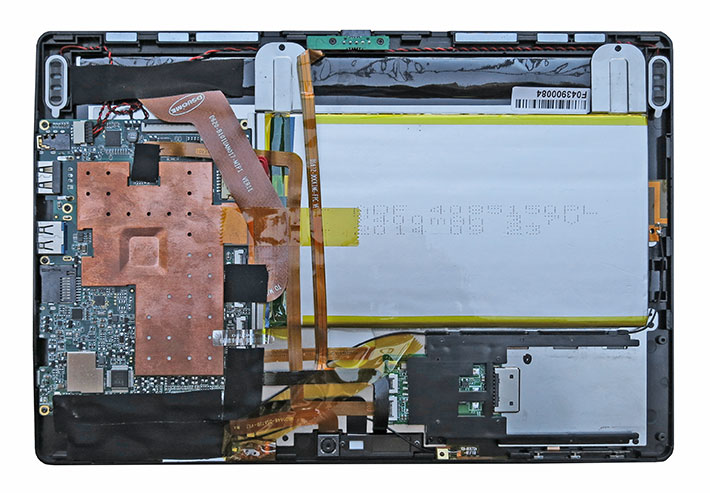
The motherboard measures about 115 x 82 mm and has all of its edge-mounted I/O concentrated along one side of the main board. The Flex 10 does not need a fan. Instead, there's a thin copper heat-spreader plate that spreads and dissipates heat generated by the processor and ancillary circuitry.
To the right of the main board is the Flex 10 battery. It is a thin 5-1/2 x 3-1/4 inch affair that is not accessible from the outside and not user-replaceable. It's however accessible enough so that a service department could easily get to it and probably replace it. Company specs claims a capacity of 6,500mAH (MobileDemand says 28.9 watt-hours) and 5 hours battery life.
There is a roughly 2.5 x 1.5 inch card compartment on the lower right with labeling that suggested WWAN and MiFi. We couldn't initially figure out what it was. Turns out it's for an UltraStick, something Huawei originally proposed to easily add WWAN functionality to flatscreen TVs, but can also be used to provide WWLAN to lower-end tablets.
There are no miniPCIe or other expansion connectors visible, nor can you see the storage or RAM modules. That's because the tablet's eMMC (the "e" stands for "embedded") storage is part of the motherboard and RAM is likely as well.
To get the tablet back into its protective multi-layered casing, you first pull the soft rubber boot over it, then push the assembly back into the rigid backplate. It requires a bit of careful pushing and prodding to get everything settled again in its proper place, so we wouldn't do this too often.
Superb IPS 1920 x 1200 pixel capacitive multi-touch display
While the Flex 10's mass storage makes some heavy concessions to the quest for affordability, the display definitely does not. Measuring a comfortable 10.1 inches diagonally — significantly larger than the 7-inch screen of MobileDemand's workhorse xTablet T7200 — and it offers full WUXGA resolution. That's 1920 x 1200 pixel in 16:10 wide-format — more pixels than all of today's 1080p flatscreen HDTVs. On a 10-inch tablet screen, that makes for a super-sharp picture. Almost needless to say, the xTablet Flex 10 uses 10-point projected capacitive multi-touch for effortless tapping, panning, pinching and zooming. And the 350 nits display is of the IPS (in-plane switching) variety that makes for perfect viewing from all angles.
To see how well it works, we compared the xTablet Flex 10 with a third generation iPad whose formidable "retina" display is said to have a backlight strength of about 400 nits. Placed side by side outdoors on an overcast morning in a semi-shaded area, both displays appeared very bright and very vibrant. Both tablets have those fashionably glossy bezels and both display surfaces show strong reflections. The images below speak for themselves. The Flex 10 performs as one would expect from a modern, high-quality consumer tablet.
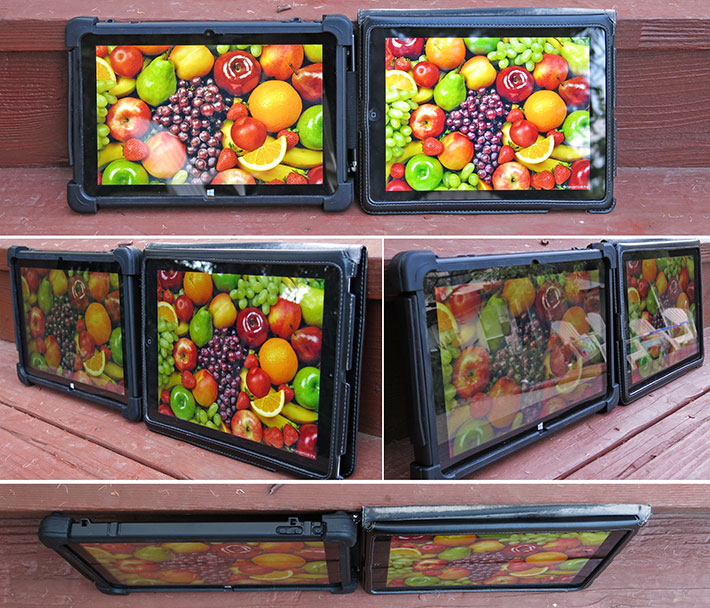
Like a rapidly increasing number of tablets offered to industrial and vertical market customers, the xTablet Flex 10 has a projected capacitive touch interface. We did test the 10-point multi-touch claim by using all ten fingers to draw lines in MSPaint. The Flex 10 does recognize ten separate inputs.
MobileDemand supplies a capacitive pen with a foot-long lanyard. The pen is of the passive capacitive variety and has the broad tip that works well for tapping and panning, but not for precision work. To MobileDemand's credit, they replaced the usually short and chintzy generic capacitive pens with their rubber tips with a metal mesh tipped stylus that's more durable, works somewhat better, and is longer and thicker than generic styli. And they also used their standard and very durable tether and stylus holder to store the pen when it's not in use.

It's been our experience that capacitive touch controllers have very narrow tolerances of what they do and do not recognize as touch/contact. There are now some such controllers that can sense touch even from a small fraction of an inch away from the surface, and that makes such systems somewhat usable with thin gloves. The Flex 10 is not one of them, and it appears that the addition of the relatively thick protective screen cover, which adds a small bit of distance between finger and glass surface, means the Flex 10 requires a slightly firmer touch than it otherwise would.
We tried handwriting recognition with it, and it works remarkably well. Ink goes on much better than on resistive digitizers, but still nowhere near as well as on a Wacom style active digitizer.
Cameras
The xTablet Flex 10 has two integrated cameras. The user-facing 2mp camera is for video conferencing, whereas the rear-facing 5mp camera with LED flash can be used for documentation purposes.
Cameras integrated into vertical and industrial market handheld and tablet computers have historically underperformed compared to even low-end dedicated cameras and, more recently, the cameras available in almost every smartphone. Things have gotten a bit better, but usually not enough to eliminate the need of taking along a dedicated camera or smartphone if photo or video documentation is needed on the job.
Here, interestingly, the Flex 10 benefits from the conception of the underlying generic tablet as a consumer product — its cameras are at least as good as we've seen even from high-end dedicated rugged devices, and possibly even better. As a result, the Flex 10 can definitely be used for project documentation.
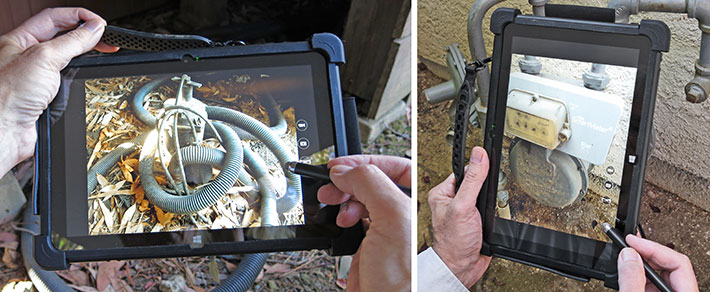
The Flex 10's documentation camera, especially, is quite decent and capable of taking good quality pictures up to 2592 x 1944 resolution. The focus is fast but tends to be a bit soft. The camera does not compress images so much that they become useless.
Below are pictures shot with the Flex 10 camera in its default 2592 x 1944 pixel resolution (click for full size):
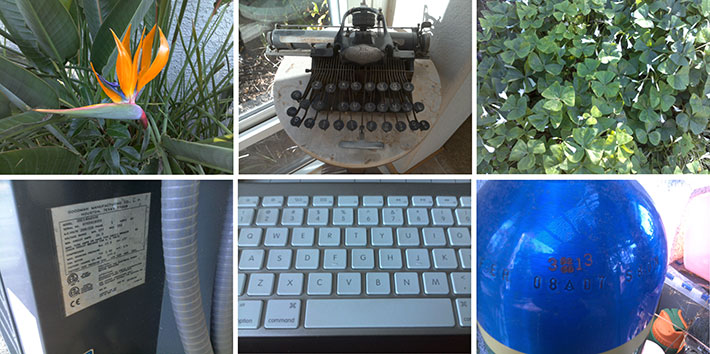
Default 1080p video, too, works remarkably well. The camera does not fall behind and the image is sharp enough.
Ruggedness
Here it gets interesting. The Flex 10 tablet itself is consumer-grade, but, neatly protected inside its rugged case, it can actually survive the MIL-STD-810G 26 drops from four feet onto concrete. That's impressive.
MobileDemand says that you can also drop an 8-ounce steel ball from a meter onto its screen and it won't get hurt due to the special screen protector (we didn't try that!).
The operating temperature range is narrower than for MobileDemand's fully rugged gear, but 32 to 120 degrees Fahrenheit should cover most business users' needs.
Despite its protective casing and nicely implemented protective rubber plug for all I/O ports, the Flex 10 isn't considered a sealed unit and does not have an IP rating. That means no working in the rain. However, the special coating on the screen protector makes water perl off.
The video clip to the right shows some of the "torture chamber" tests MobileDemand subjected the Flex 10 to.
In MobileDemand's own words, "the rugged case has two layers for drop protection. The first layer is rubber with bumpers similar to what you see on other fully rugged MobileDemand tablets. The second layer is a high impact polycarbonate case that holds the rubber layer in place, but also provides mounting details for critical user carrying accessories including a back hand strap, a briefcase handle, a stylus holder, I/O door cover, and a MiFi pouch."

So, again, while the xTablet Flex 10 looks like a fully rugged device, it is a consumer tablet inside a very intelligently designed case system. It can handle a lot more abuse than any sleek consumer tablet, but it is not a sealed unit and it is not designed for use in truly harsh and unforgiving environments.
Mounting options
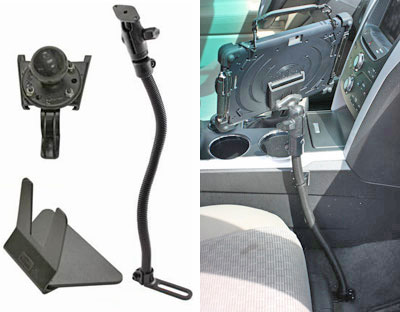 Most tablets used in business or on the job come with some kind of docking and mounting options, and the Flex 10 is no different. While MobileDemand does not offer the full office and vehicle docks available for most of its higher end tablets, its "snap mount" system allows use with a simple desk stand. Most tablets used in business or on the job come with some kind of docking and mounting options, and the Flex 10 is no different. While MobileDemand does not offer the full office and vehicle docks available for most of its higher end tablets, its "snap mount" system allows use with a simple desk stand.
For vehicle use, MobileDemand provides a flexible arm that can easily be installed on the passenger side using the same bolt that secures the passenger seat to the floor.
The arm works with the RAM-Mount ball system with the standard AMPS hole pattern. There are both 2-hole and 4-hole mounts for use with RAM's type B ball adapters, or even the large type C ball round base for heavy duty applications.
The image to the right shows some of the mounting components, as well as an actual example of a tablet mount install in a vehicle.
Bottom line: MobileDemand xTablet Flex 10
With the new MobileDemand xTablet Flex 10 10.1-inch tablet, the company breaks new ground by combining a modern, competent Windows 8.1 media tablet with a specially designed and preinstalled elaborate case that provides very respectable ruggedness. 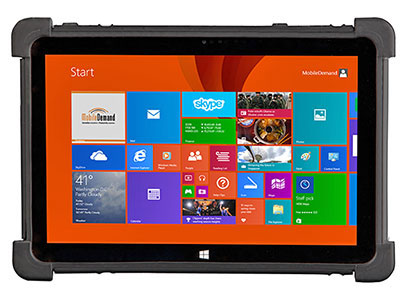 To get this much performance in an impressively well protected package from a well-established provider of rugged tablet computers for so little money is nothing short of amazing. The whole package, including the industrial-grade briefcase carrying handle and heavy duty handstrap costs less than an iPad Air 2! To get this much performance in an impressively well protected package from a well-established provider of rugged tablet computers for so little money is nothing short of amazing. The whole package, including the industrial-grade briefcase carrying handle and heavy duty handstrap costs less than an iPad Air 2!
Weighing just 2.25 pounds including case, handle and handstrap, MobileDemand's second "thin-and-light" offers a new answer for customers who seek the convenience, low cost and ease of use of a sleek consumer media tablet in something that's better protected and doesn't cost anywhere near as much as a fully rugged (or even semi-rugged) tablet.
The Flex 10's quad-core Intel "Bay Trail" processor yields impressive performance, the kind available only from Intel Core-powered (and more expensive) devices just a couple of years ago.
The low cost might one lead to expect low-end components and performance, but the xTablet Flex 10 impresses with an very sharp, bright and vibrant display that offers high 1920 x 1200 pixel resolution, a perfect viewing angle from all directions, and no color shifts. Its 10-point capacitive multi-touch screen is quick and very responsive, and works well with Windows 8.1 and touch-optimized applications. The included capacitive stylus has the usual broad tip, but it's of the metal mesh variety and works quite well.
For an inexpensive thin-and-light tablet the Flex 10 has good onboard connectivity, including both USB 3.0 and USB 2.0 ports, and micro-HDMI. The 2mp and 5mp cameras offer consumer tablet performance (i.e. quite good).
Inside its excellent rubber and polycarbonate casing, the xTablet Flex 10 is remarkably well protected and can likely handle a good deal of abuse. It is not sealed, however, and temperaturewise the tablet can handle almost anything.
Offering good performance, very low power draw, a very good hi-res display, and surprising ruggedness, the fanless xTablet Flex 10 represents a compelling, and compellingly inexpensive, package for anyone who needs Windows on tough jobs that don't require the higher protection (and cost) of a fully rugged device.
That said, the very low cost also means some compromises. Unlike the T1400, the Flex 10 does not offer Windows 7, is not sealed, does not have a replaceable battery, does not offer a scanner (nor RFID or GPS), and mounting options are more limited. If that doesn't matter, the xTablet Flex 10 (or its smaller Flex 8 sibling) may well fit the (small) bill.
-- Conrad H. Blickenstorfer, November 2014
MobileDemand xTablet Flex 10 Specs:
| Type |
Thin-and-light rugged Windows Tablet PC
|
| Added |
Added 08/2014, full review 11/2014
|
| Processor |
Quad-core Intel Bay Trail Z3770
|
| Processor speed |
1.46GHz, 2.39GHz burst frequency
|
| Scenario Design Power |
2 watts |
| Display Chipset |
Intel HD Graphics |
| OS |
Windows 8.1 or 8.1 Professional |
| Memory |
4GB LPDDR3-1066 |
| Display |
IPS LCD with 350 nits LED backlight |
| Display size/res |
10.1-inch, 1920 x 1200
|
| Digitizer |
OGS (One Glass Solution) 10-point capacitive multi-touch/capacitive stylus |
| Keyboard |
Optional external keyboard
|
| Storage |
64GB eMMC |
| Expansion slots |
1 x micro SD, 1 x USIM |
| Housing |
Plastic tablet housing inside rubber glove with protective rubber bumpers, polycarbonate case, and briefcase handle |
| Size |
10.4 x 7.1 x 0.7 inches (265 x 180 x 18mm)
|
| Weight |
2.25 lbs. (1.02 kg) with case, handle and hand strap |
| Operating temperature |
32° to +120°F (0° to +49°C) |
| Ingress protection |
Not rated
|
| Drop/shock |
4 foot drop |
| Tumble |
1,000 one-meter tumbles (simulates 5 years worth of drops and tumbles)
|
| Vibration |
Accelerated extreme truck and forklift vibration testing, 21G peak acceleration, 10 to 1,000Hz (6 hour test simulates intense forklift vibration extremes and a total of 100,000 miles at 55mph on average US roads)
|
| Power |
Internal non user-replaceable Li-Ion 28.9 watt-hours ("6 hours") |
| Cameras |
2mp camera front, 5mp camera with LED flash rear (up to 2592 x 1944 pixel) |
| Sensors |
Light, G-sensor, Gyrometer, e-Compass
|
| Interface |
1 x micro USB 2.0 (for charging), 1 x USB 2.0, 1 x USB 3.0, 1 x micro-HDMI, audio, power, docking |
| Wireless options |
802.11a/b/g/n, Bluetooth 4.0, MiFi options for WWAN
|
| Price |
US$695 With Windows 8.1, US$845 with Windows 8.1 Pro |
| Warranty |
TBD
|
| Contact |
xTablet Flex 10 web page |
| Brochure |
 xTablet Flex 10 PDF spec sheet xTablet Flex 10 PDF spec sheet |
(copyright 2014 RuggedPCReview.com)
|




